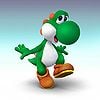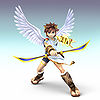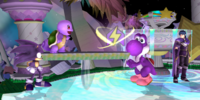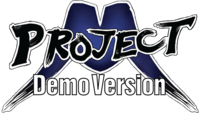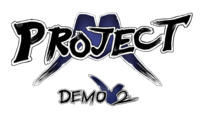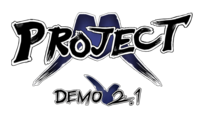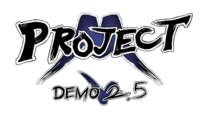Project M: Difference between revisions
KallyWally (talk | contribs) |
(→Errors) |
||
| Line 280: | Line 280: | ||
===Errors=== | ===Errors=== | ||
Despite having numerous updates over time, Project M still experiences some minor errors outside the regular Versus modes, which include: | Despite having numerous updates over time, Project M still experiences some minor errors outside the regular Versus modes, which include: | ||
*Pokémon Trainer for Ivysaur, Charizard and Squirtle can still appear during [[Event Matches]] and the [[Subspace Emissary]]. The Pokémon will still have their modded movesets, and when using their down special moves, they will perform their respective attacks | *Pokémon Trainer for Ivysaur, Charizard and Squirtle can still appear during [[Event Matches]] and the [[Subspace Emissary]]. The Pokémon will still have their modded movesets, and when using their down special moves, they will perform their respective attacks but the trainer will still shout "Get back!". Using them for too long in this state may cause the game to freeze. | ||
*Because the single-player Roy and Mewtwo assets are incomplete as of 3.0, when completing [[Classic]] or [[All-Star]] with a character, the trophy shown will always be that of {{SSBB|Mario}} (though when viewing in the Vault, characters will still have their trophies collected as usual), and the FMV after the [[Character Roll Call]] will always be that of the Subspace Emissary introduction. | *Because the single-player Roy and Mewtwo assets are incomplete as of 3.0, when completing [[Classic]] or [[All-Star]] with a character, the trophy shown will always be that of {{SSBB|Mario}} (though when viewing in the Vault, characters will still have their trophies collected as usual), and the FMV after the [[Character Roll Call]] will always be that of the Subspace Emissary introduction. | ||
*[[Tourney]] mode will freeze the game when attempting to select a character. | *[[Tourney]] mode will freeze the game when attempting to select a character. | ||
Revision as of 18:42, December 29, 2013
Project M is a hack for Super Smash Bros. Brawl designed to make the gameplay more closely resemble that of Super Smash Bros. Melee mainly, and also Super Smash Bros. to a lesser extent. The development team is partly descended from the original developers for Brawl+, now known as the PMBR, or Project M Backroom. It has members from over ten countries, though as of now, only an NTSC version has been released.[1]
Project M has been featured as a prominent event at several national tournaments, such as GENESIS 2, the Zenith series, and is on the game lineup for Apex 2014.
Universal changes
The actual version of Project M has two versions: Full Set and Wi-Fi. The former has Stock Control and Input Assistance as new features, which allow newer players to use advanced techniques better and have a stock advantage over experienced ones. However, Replays and online play won't work properly; if a Project M replay is viewed on the regular Brawl, it may cause malfunctions when beginning a match, possibly because of the stage replacement. The Wi-Fi version allows these two things to work properly, and while it keeps the former version's battle features, these are not implemented for online play, likely because Stock Control would have caused potential griefing within matches (by the distant opponent always choosing the maximum amount of stocks).
Both versions alter the original Brawl gameplay to be more resemblant to that of Melee, along with other changes to make the game more competitive in general, while keeping other Brawl beneficial techniques such as crawl, wall cling or DACUS. These changes include:
- The following mechanics have been altered to match their Melee forms:
- All characters have faster falling speeds and gravity, and more forwards momentum from a dash is conserved when jumping.
- Air dodging applies a directional boost and causes helplessness, implementing wavedash techniques.
- L-canceling halves landing lag when a shield button is pressed 7 frames before landing, and characters will flash white if performed correctly.
- Dash dancing's timing has been reverted, and characters can shield during one.
- Crouching cancels dashes.
- Crouch canceling reduces knockback.
- Consecutive jabbing is removed.
- Hitting the C-Stick down while crouching uses a down smash (in Brawl it uses a down tilt).
- Double jump canceling reimplemented; its usage varies slightly between characters.
- The abilities to ledge tech and edge cancel attacks have been implemented.
- Jumps can be canceled with grabs.
- Powershielding can reflect projectiles during the first 2 frames.
- Shieldstun formula reverted. Characters now also take longer to act out of a shield drop.
- Edges cannot be auto-sweetspotted, so they cannot be grabbed neither from the back, nor during the attacking portion of recovery attacks. Some moves like Raptor Boost or Bowser Bomb still use this feature, though.
- Window for teching reverted.
- Amount of freeze frames reduced.
- Hitstun canceling has been removed.
- Random tripping has been removed.
- Items cannot be grabbed during dash attacks or aerials. Compared to in Melee, though, air dodges still auto-grab them, making it easier to counter item-based attacks.
- Grab aerials cause helplessness if they miss a ledge, but can be used after an air dodge with the shield + attack combination, like in Melee. They still act as tether recoveries, though they won't restore a character's midair jumps if they drop from the ledge.
- If an already-struck character gets hit by something else, the new knockback either replaces the old knockback (if the gap between the attacks was 10 frames or less) or has its direction and power combined with the old knockback (after 10 frames). (In Brawl, whether to replace the old knockback is based on the relative power of the two attacks, and no merging is performed.)
- Brawl's random input delay is fixed.
- Meteor smash angle reverted, therefore implementing spikes.
- When dash-grabbing a foe, forward momentum is completely negated. Characters with low traction still possess this feature, though.
- Grab released characters will get back their midair jumps (though the grab release glitch has not been removed).
- Pummels reverted to all having the same standarized speed and dealing 3% damage per use; the only exceptions being Bowser and Zelda, whose pummels deal 4% damage, and Ivysaur, whose pummel deals 2%.
- Grab physics reverted: characters can grab opponents behind them, though they cannot be grabbed by the lower legs or arms.
- Locking is removed: characters hit when lying on the floor will bounce shortly and then get up automatically as in Melee. If the character bounces away without making contact with the ground, they will assume their falling animation.
- Footstool jumping is done with a taunt input.
- Tether recoveries now ignore edge-hoggers; characters will still grab the ledge without affecting them, and when pulled up they will perform an automatic jump get-up. This gives characters reliant on this technique a much better and safer recovery, and makes them harder to punish.
- Tripping can be teched.
- A glide toss can be done in the air.
- Smash 64's taunt canceling returns.
- Gliding is no longer usable with a jump button: a special move must be used instead to do so.
- Stages such as Dream Land, Hyrule Castle and Fountain of Dreams replace stages such as Bridge of Eldin and 75m.
- Buffering now works differently: the game normally has no buffering, like in Melee, though players can turn on Input Assistance to implement a 3-frame buffer window for helping newer players master advanced techniques, replacing the "Damage Gauge" option. Online matches instead have a different Buffer option that replaces handicaps, from 1 to 30, with these numbers being the respective amount of buffer frames.
- Stock Control added, replacing handicaps. Players can now control the amount of stocks each player starts with before battle, from 1 to 30 stocks for each individual character. A Crew mode has been added in which the game keeps track of stocks retained after battles.
- Stage selection menu modified to include built-in stage striking control (Full Set version).
- Super Armor has been removed. Standardized knockback resistance system categorizes armor as Light, Medium, or Heavy. Some characters feature color overlays to indicate such armor, with more opaque overlays generally indicating stronger armor.
- Special Brawl's "Curry Mode" is replaced with "Turbo Mode," in which all moves can cancel into any other move or action on hit or on shield.
Other changes and tweaks
- L and R Buttons for the GameCube controllers were tweaked so that the player can input any actions requiring them by just light-pressing them, rather than pressing all the way down, making easier to use techniques such as wavedashing, L-canceling, or even shielding itself (due to Project M's lack of lightshields).
- New Melee-like designs for the menu and character selection screens, with altered writing.
- The game in general takes less time to load modes, characters and scenes, and things such as Records can be scrolled through quicker.
- Brawl mode is now labeled as "Fight!", and all other modes and sections containing "Brawl" are replaced with "Smash" (such as Multi-Man Brawl being named Multi-Man Smash).
- Default match type is 4 stock with an 8-minute timer, and Team Attack is turned on by default.
- Altered camera that behaves similarly to in Melee's Camera Mode, as well as being capable of zooming out indefinitely and rotating around the entire stage, allowing to unrestrictedly take snapshots.
- Stage selection screen revamped: stages are now ordered at the bottom in a rectangular shape, with the selected stage being displayed at the top. Stages are now also ordered in Pages 1 and 2, and the top background displays Project M.
- Victory screen for VS. battles altered to be entirely black like in Melee.
- Independent character icons for Zelda/Sheik and Samus/Zero Suit Samus.
- Characters now grunt instantly when hit by a strong attack, as in Melee and 64, while in Brawl they did a second afterwards. There are also medium-damage and high-damage groans as well, with most characters using unused voice samples from the Sound Test. Characters now also use voice samples for sidesteps and air dodges, and variable voices for smash attacks.
- Characters now emit a spark when wall jumping.
- The cast of characters and background at the beginning of the opening movie is slightly altered, and both it and the title screen now display "Super Smash Bros. Project M".
- Training mode now appears as the default Solo mode, and after entering it, the same characters that participated will appear chosen automatically for Group battles.
- Home-Run Contest stadium no longer has a protective window, acting like its Melee counterpart. Its online competitive mode has also been added as a co-op mode offline, with records being saved.
- No Replay time limit.
- Many additional costumes are added for each character, and are shown on the characters profiles as "Colors". There are now also "Special" costumes for some characters, such as Dr. Mario for Mario, Shadow Queen Peach for Peach, and Armored Mewtwo for Mewtwo, some of which get team colors and changed aesthetics.
- Due to issues with slow motion, Timers are removed and replaced with ordinary stickers, even for Training mode. Superspicy Curry is replaced with a "Turbo" item that causes characters to act like in Turbo Mode for a short period. Poké Ball Pokémon are also changed slightly: Latios & Latias deal half their usual damage, and Weavile no longer stuns opponents, instead sending them on a weak upwards trajectory. Other items remain unchanged, though, aside from a few Final Smashes.
Characters
In addition to many universal changes, individual characters were heavily modified from their Brawl versions. Characters were largely buffed overall, creating a broad collection of high tier characters with varying play styles, strengths, and weaknesses. However, some moves were nerfed to further flush out certain characters and break dependence on repeated use of a single move or set of moves. Notably, characters who performed well in Melee (such as Captain Falcon and Jigglypuff) were reverted to their Melee versions and changed from there. This includes special and normal moves, properties such as gravity, weight, run-speed, air mobility but does not include sound effects, textures, or vertexes. However, some characters, due to having poor attributes and movesets in Melee (such as Ness, Kirby or Zelda), had some elements recycled from Brawl and Smash 64 and/or have been given entirely new buffs.
List of characters
* Characters not in Brawl
Stages
- Battlefield (Stage layout slightly tweaked to match Melee's Battlefield.)
- Big Blue
- Brinstar
- Castle Siege (skips second stage)
- Dracula's Castle[2] (replaces Luigi's Mansion)
- Corneria
- Dreamland 64 (replaces Green Greens, as well as "Fountain of Dreams" theme with Smash 64's Dream Land theme.)
- Distant Planet (Originally SSE: Jungle, but was revamped in 3.0 to resemble Distant Planet.)
- Final Destination (with custom model and background resembling that of Melee's version)
- Flat Zone 2
- Fountain of Dreams (replaces Mario Bros., as well as its theme with Fountain of Dream's.)
- Fourside (replaces New Pork City, and replaces "Porky's Theme" with Fourside's.)
- Frigate Orpheon
- Green Hill Zone (Made into a neutral stage with 1 rotating platform. The Green Hill Zone of Brawl can be seen in the background.)
- Halberd (Raised ceiling and claw removed.)
- Hyrule Castle (No tornado hazards; replaces Bridge of Eldin. Also replaces "The Hidden Village" theme with Hyrule Castle's.)
- Jungle Japes (unswimable water)
- Kongo Jungle (No Barrel Cannon; replaces 75 m. Also replaces "25 BGM" theme with Kongo Jungle's.)
- Lylat Cruise (stage doesn't tilt)
- Metal Cavern (Remade Meta Crystal, replaces Mushroomy Kingdom. Also replaces "Ground Theme (Super Mario Bros.)" theme with Meta Crystal music from Smash 64.)
- Norfair (Different layout with moving platforms and no hazards)
- Onett
- Pictochat (some transformations are gone)
- Pirate Ship (nerfed hazards)
- Pokémon Stadium 2 (No stage transformations. Center platform has a Master Ball drawing, and small televisors at the background display "Project M".)
- Pokémon Stadium (Windmill has been moved to the background and edges were tweaked to let characters recover more easily.)
- Princess Peach's Castle (No block switches nor Banzai Bills; replaces Mario Circuit and its theme with Princess Peach's Castle's.)
- Rainbow Cruise (Donut block lifts can be passed through like in Melee. "Princess Peach's Castle" theme is replaced with Mushroom Kingdom II's from Melee.)
- Rumble Falls (Made into a neutral stage with a bridge and 3 platforms.)
- Saffron City (No Pokémon; replaces Spear Pillar, as well as "Victory Road" theme with Saffron City's.)
- Shadow Moses Island
- Skyloft[3] (Replaces Hanenbow, using "Hyrule Field Theme".)
- Skyworld (Bottom most platform is unbreakable and breakable platforms are clouds.)
- Smashville
- Summit
- Temple
- Training Room (Large stage with checkered surfaces, a wall at the left and a pit at the right: replaces Online Practice Stage.)
- Warioware (without microgames)
- Yoshi's Island
- Yoshi's Story (No Fly Guys; replaces Yoshi's Island (SSBM), as well as "Super Mario Bros. 3" theme with Yoshi's Story's.)
Turbo Mode
As of version 3.0, the Curry effect is replaced with a new one - Turbo. In Turbo mode, players are able to cancel any successful attack, upon hit or shield, into any other action except the same attack, and all aerial attacks auto cancel when landing, if they hit. Certain moves, such as Farore's Wind, consist of multiple actions and can be canceled into themselves. Turbo Mode has been compared to the Marvel vs. Capcom series, because it enables skilled players to perform extensive combos.
Turbo mode can be selected from the Special Brawl menu, or temporarily granted by the "Turbo" item, which replaces Superspicy Curry.
Notable Turbo-related resources:
- The official Turbo Mode blog post.
- Melee Impossible, the original inspiration for Turbo Mode.
- The official Turbo Tuesdays playlist, beginning with the April Fools video that revealed Turbo mode.
- Going Turbo, by Sethlon. The first Turbo combo video to feature no tool assisted inputs.
Release history
Demo 1.0
Released February 8, 2011
- 14 characters available
Demo 2.0
Released April 17, 2012
- Added 15 characters
Demo 2.1
Released May 23, 2012
- Major bug fixes
Demo 2.5
Released December 29, 2012
- Added 4 characters
- Ledge teching implemented
- Melee knockback stacking implemented
- Input Assistance and Stock Control implemented
- New aesthetic changes which include new palette swaps and new menu designs.
Demo 2.5b
Released January 6, 2013
- Various Minor Bug Fixes
Demo 2.6
Released July 17, 2013
- Added 1 character
The PMBR announced Project M 2.6 along with their new website design.
Demo 2.6b
Released August 15, 2013
- Various Bug Fixes
Demo 3.0
Released December 9, 2013
- Added 7 characters
- Turbo mode added.
- Princess Peach's Castle added, Norfair revamped, Distant Planet revamped, Training Room stage added.
- Numerous alternate costumes for several characters added, including Dr. Mario.
Formerly, an April Fools' video[4] announced that 3.0 would contain a universal gameplay change where all moves can cancel into any other move or action on hit or on shield. While the change being universal was a joke, it finally became available for play as "Turbo Mode" in Special Brawl, replacing the "Curry" option. Project M 3.0 also marks the first version to contain the entire Brawl roster, along with Roy and Mewtwo, and features many new alt costumes, such as Dr. Mario as an alternate skin for Mario, akin to Wario's biker and plumber skins. Other skins are: Melee Fox, Shadow Queen Peach, Ocarina of Time Link, Dry Bowser, Party Hat and Pirate Hat Pikachu, Crown and Fairy Jigglypuff, Armored Mewtwo, Mr. L, Virtual Boy R.O.B., Outset Toon Link, Classic Wolf, Boxer Donkey Kong, Pajama Ness, Masked Man Lucas, Fire Peach, additional Yoshi colors, Melee Falco, and Concept Art Meta Knight.
Errors
Despite having numerous updates over time, Project M still experiences some minor errors outside the regular Versus modes, which include:
- Pokémon Trainer for Ivysaur, Charizard and Squirtle can still appear during Event Matches and the Subspace Emissary. The Pokémon will still have their modded movesets, and when using their down special moves, they will perform their respective attacks but the trainer will still shout "Get back!". Using them for too long in this state may cause the game to freeze.
- Because the single-player Roy and Mewtwo assets are incomplete as of 3.0, when completing Classic or All-Star with a character, the trophy shown will always be that of Mario (though when viewing in the Vault, characters will still have their trophies collected as usual), and the FMV after the Character Roll Call will always be that of the Subspace Emissary introduction.
- Tourney mode will freeze the game when attempting to select a character.
- Though the Pokémon Trainer's Pokémon will still have records saved for him, they cannot be viewed unless the regular Brawl is booted up.
- For the Wi-Fi version, Stock Control and Input Assistance are still labeled as "Buffer" and "Damage Gauge", respectively.
- If the stage is selected to be Random via the battle rules (and not the stage selection screen), the game will freeze upon confirming it. It will also freeze is Stock Control is activated and no stocks are selected for a character.
- Most of the characters' Special costumes, as well as using Mewtwo or Roy, may cause the game to lag unexpectedly when too many characters and things are on in Team Battles or Free-for alls. For players to be aware of this, especially on tournaments, these costumes' artworks display a small warning sign over them.
Downloading instructions
Project M can be downloaded here and only requires a SD card, non-PAL Wii, and Brawl disc.
<youtube>AL_tz-ObIGM</youtube>
Developers
- Project Leaders: Shanus, SHeLL, Magus, Strong Bad, jiang, Shadic, haloedhero, Yeroc
- Magus: Magus
- Playtesters: Historically, the PMBR has had playtesters such as Hungrybox, Mango, Lucky, KirbyKaze, Amsah, and many more. The current playtester team consists of Gimpyfish62, TheReflexWonder, Fuzzyness, Professor Pro, Fly Amanita, and Jolteon, among many, many others.
- Graphics/Menu Design: FireBall Stars, ds22
- Animation: haloedhero, SiLeNtDo0m
- Stage Design: Mewtwo2000, Shadic, Vanguard, SOJ
Applications to the Project M Backroom can be made at the application subforum.
References
External Links
| Playable characters in Project M and Project+ | |
|---|---|
| Playable characters | Bowser (Giga Bowser) · Captain Falcon · Charizard · Diddy Kong · Donkey Kong · Falco · Fox · Ganondorf · Ice Climbers · Ike · Ivysaur · Jigglypuff · King Dedede · Kirby · Knuckles · Link · Lucario · Lucas · Luigi · Mario · Marth · Meta Knight · Mewtwo · Mr. Game & Watch · Ness · Olimar · Peach · Pikachu · Pit · R.O.B. · Roy · Samus · Sheik · Snake · Sonic · Squirtle · Toon Link · Wario (Wario-Man) · Wolf · Yoshi · Zelda · Zero Suit Samus |





